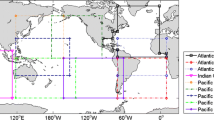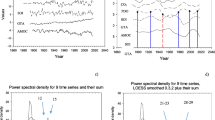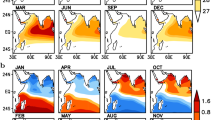Abstract
A hypothesized low-frequency climate signal propagating across the Northern Hemisphere through a network of synchronized climate indices was identified in previous analyses of instrumental and proxy data. The tempo of signal propagation is rationalized in terms of the multidecadal component of Atlantic Ocean variability—the Atlantic Multidecadal Oscillation. Through multivariate statistical analysis of an expanded database, we further investigate this hypothesized signal to elucidate propagation dynamics. The Eurasian Arctic Shelf-Sea Region, where sea ice is uniquely exposed to open ocean in the Northern Hemisphere, emerges as a strong contender for generating and sustaining propagation of the hemispheric signal. Ocean-ice-atmosphere coupling spawns a sequence of positive and negative feedbacks that convey persistence and quasi-oscillatory features to the signal. Further stabilizing the system are anomalies of co-varying Pacific-centered atmospheric circulations. Indirectly related to dynamics in the Eurasian Arctic, these anomalies appear to negatively feed back onto the Atlantic‘s freshwater balance. Earth’s rotational rate and other proxies encode traces of this signal as it makes its way across the Northern Hemisphere.













Similar content being viewed by others
Notes
Terminology: We refer to stages of a cooling either as the minima of Groups I through IV, or as peak values of Groups -I, -II, -III, and -IV.
Winter indices of NAO and AO behave differently from their annual counterparts. In table and figure legends used in this paper, we emphasize the use of winter indices by adding the letter ‘w’: e.g. NAOw and AOw.
This is in contrast to AMO in all stadium-wave figures, where AMO is plotted in its negative polarity (ngAMO).
References
AARI (2007) Sea ice charts of the Russian Arctic in gridded format 1933–2006, Arctic and Antarctic Research Institute. In: Smolyanitsky V, Borodachev V, Mahoney A, Fetterer F, Barry R (eds) Boulder, Colorado USA, National Snow and Ice Data Center, Digital media
Alexeev VA, Ivanov VV, Kwok R, Smedsrud LH (2013) North Atlantic warming and declining volume of arctic sea ice. Cryosphere Discuss 7:245–265. doi:10.5194/tcd-7-245-2013
Alkire MB, Falkner KK, Rigor I, Steele M, Morison J (2007) The return of Pacific waters to the upper layers of the central Arctic Ocean. Deep Sea Res Part I 54:1509–1529
Asmus VV, Krovotyntsev VA, Milekhin OE, Trenina IR (2005) Study of multiyear dynamics of Sea Ice in the Arctic from satellite radar data: issues of processing and interpretation of the earth’s radar sounding data. St. Petersburg: Gidroeteoizdat [proc. RC Planeta, 1(46):155–172 [in Russian]]
Beamish RJ, McFarlane GA, Noakes D, King JR, Sweeting RM (1998) Evidence of a new regime starting in 1996 and the relation to Pacific salmon catches (NPAFC Doc 321) 31p. Dept of Fisheries and Oceans, Sciences Branch-Pacific Region, Pacific Biological Station, Nanaimo, BC, Canado V9R 5K6
Bengtsson L, Semenov VA, Johannessen OM (2004) The early twentieth-century warming in the Arctic—a possible mechanism. J Clim 17:4045–4057
Black D, Peterson LC, Overpeck JT, Kaplan A, Evans MN, Kashgarian M (1999) Eight centuries of North Atlantic Ocean Atmosphere variability. Science 286:1709–1713. doi:10.1126/science.2865445.1709
Bretherton CS, Widmann M, Dymnikov VP, Wallace JM, Blade I (1999) The effective number of spatial degrees of freedom of a time-varying field. J Clim 12:1990–2009
Broomhead DS, King GP (1986) Extracting qualitative dynamics from experimental data. Physica D 20:217–236
Ceballos LI, Di Lorenzo E, Hoyos CD, Schneider N, Taguchi B (2009) North Pacific Gyre Oscillation synchronizes climate fluctuations in the eastern and western boundary systems. J Clim 22:5163–5174
Di Lorenzo E, Schneider N, Cobb KM, Franks PJS, Chhak K, Miller AJ, McWilliams JC, Bograd SJ, Arango H, Curchitser E, Powell TM (2008) North Pacific Gyre Oscillation links ocean climate and ecosystem change. Geophys Res Lett 35:L08607. doi:10.1029/2007GL032838
Di Lorenzo E, Cobb KM, Furtado JC, Schneider N, Anderson BT, Bracco A, Alexander MA, Vimont DJ (2010) Central Pacific El Niño and decadal climate change in the North Pacific Ocean. Nature Geosci 3(11):762–765. doi:10.1038/NGEO984
Dickey JO, Marcus SL, Chin TM (2007) Thermal wind forcing and atmospheric angular momentum: origin of the Earth’s delayed response to ENSO. Geophys Res Lett 34:L17803. doi:10.1029/2007GL030846
Dickey JO, Marcus SL, de Viron O (2011) Air temperature and anthropogenic forcing: insights from the solid earth. J Clim 24:569–574. doi:10.1175/2010JCLI3500.1
Donohoe A, Marshall J, Ferreira D, McGee D (2013) The relationship between ITCZ location and cross-equatorial atmosphere heat transport: from the seasonal cycle to the last glacial maximum. J Clim 26:3597–3618
Elsner JB, Tsonis AA (1996) Singular spectrum analysis: a new tool in time series analysis. Springer, Berlin
Francis JA, Hunter E (2007) Changing fabric of the arctic blanket. Environ Res Lett 2:045011. doi:10.1088/1748-9326/2/4/045011
Frierson DMW, Hwang Y-T (2012) Extratopical influence on ITCZ ahifts in slab ocean simulations of global warming. J Clim 25:720–733
Frolov IE, Gudkovich AM, Karklin BP, Kvalev EG, Smolyanitsky VM (2009) Climate change in Eurasian Arctic Shelf Seas, Springer-Praxis Books, ISBN 978-3-540-85874-4, 165p
Ghil M, Allen MR, Dettinger MD, Ide K, Kondrashov D, Mann ME, Robertson AW, Saunders A, Tian Y, Varadi F, Yiou P (2002) Advanced spectral methods for climatic time series. Rev Geophys 40(1):3.1–3.41. doi:10.1029/2000GR000092
Girs AA (1971a) Multiyear oscillations of atmospheric circulation and long-term meteorological forecasts. L. Gidrometeroizdat 480 p. [in Russian]
Girs AA (1971b) Long-term fluctuations of the atmospheric circulation and hydrometeorological forecasts. L., Hydrometeorological monographs, St. Petersburg, Russia. 280p [in Russian]
Gross RS, Fukumori I, Menemenlis D (2005) Atmospheric and oceanic excitation of length-of-day variations during 1980-2000. J Geophys Res 110:B09405. doi:10.1029/2004JB003565
Gudkovich ZM, Nikolayeva AY (1963) Ice drift in the Arctic Basin and its relation to sea ice extent of the Arctic Seas. AARI Proc 104: 212. [in Russian]
Gudkovich ZM, Karklin VP, Kovalev EG, Smolyanitsky VM, Frolov IE (2008) Variations of sea ice cover and other constituents of the climate system in the Arctic and Antarctic in connection with polar vortex evolution. Probl Arctic Antarct 78:48–57 (in Russian)
Honda M, Inoue J, Yamane S (2009) Influence of low Arctic sea-ice minima on anomalously cold Eurasian winters. Geophys Res Lett 36:L08707. doi:10.1029/2008GL037079
Hurst HE (1951) Long-term storage capacity of reservoirs. Trans Am Soc Civil Eng 116:770–799
Jault D, Gire C, Le Mouel J-L (1988) Westward drift, core motions and exchanges of angular momentum between core and mantle. Nature 333:353–356
Johannessen OM, Bengtsson L, Miles MW, Kuzmina SI, Semenov VA, Alekseev GV, Nagurnyi AP, Zakharov VF, Bobylev LP, Pettersson LH, Hasselmann K, Cattle HP (2004) Arctic climate change: observed and modeled temperature and sea-ice variability. Tellus 56A:328–341
Kang S, Held I, Frierson D, Zhao M (2008) The response of the ITCZ to extratropical thermal forcing: idealized slab-ocean experiments with a GCM. J Clim 21:3521–3532
Kawasaki T (1994) A decade of the regime shift of small pelagics—from the FAO expert Consultation (1983) to the PICES III(1994). Bull Jpn Soc Fish Oceanogr 58:321–333
Keenlyside NS, Latif M, Jungclaus J, Kornblueh L, Roeckner E (2008) Advancing decadal-scale climate prediction in the North Atlantic sector. Nature 453:84–88. doi:10.1038/nature06921
King, JR, Ivanov VV, Kurashov V, Beamish RJ, McFarlane GA (1998) General circulation of the atmosphere over the North Pacific and its relationship to the Aleutian Low. (NPAFC Doc. No. 318) 18p, Dept. of Fisheries and Oceans, Sciences Branch
Klyashtorin LB (1998) Long-term climate change and main commercial fish production in the Atlantic and Pacific. Fish Res 37:115–125
Klyashtorin LB, Lyubushin AA (2007) Cyclic climate changes and fish productivity. Moscow, VNIRO Publishing, Editor for English version: Dr. Gary D. Sharp, Center for Climate/Ocean Resources Study, Salinas, CA. USA: 223 pp
Knight JR, Allan RJ, Folland CK, Vellinga M, Mann ME (2005) A signature of persistent natural thermohaline circulation cycles in observed climate. Geophys Res Lett 32:L20708. doi:10.1029/2005GRL024233
Kwok R (2011) Observational assessment of Arctic Ocean sea ice motion, export, and thickness in CMIP3 climate simulations. J Geophys Res 116:C00D05. doi:10.1029/2011JC))7004
Lambeck K, Cazenave A (1976) Long term variations in the length of day and climate change. Geophys J Int 46(3):555–573
Latif M (2001) Tropical Pacific/Atlantic Ocean interactions at multi-decadal time scales. Geophys Res Lett 28:539–542
Latif M, Roeckner E, Mikolajewicz U, Voss R (2000) Tropical stabilization of the thermohaline circulation in a greenhouse warming simulation. J Clim 13:1809–1813
Latif M, Böning C, Willebrand J, Biastoch A, Dengg J, Keenlyside N, Schweckendiek U, Madec G (2006) Is the thermohaline circulation changing? J Clim 19(18):4631–4637. doi:10.1175/JCLI3876.1
Marshall J, Donohoe A, Ferreira D, McGee D (2013) The ocean’s role in setting the mean position of the atmosphere’s ITCZ. Clim Dyn. doi 10.1007/s00382-013-1767-z
McCabe GJ, Palecki MA, Betancourt JL (2004) Pacific and Atlantic Ocean influences on multidecadal drought frequency in the United States. PNAS. 101(12):4136–4141. doi:10.1073/pnas.0306738101
Miller AJ, Schneider N (2000) Interdecadal climate regime dynamics in the North Pacific Ocean: theories, observations and ecosystem impacts. Prog Oceanogr 47(2–4):355–379
Msadek R, Dixon KW, Delworth TL, Hurlin W (2010) Assessing the predictability of the Atlantic meridional overturning circulation and associated fingerprints. Geophys Res Lett 37:L19608. doi:10.1029/2010GL044517
North GR, Bell TL, Cahalan RF, Moeng FJ (1982) Sampling errors in the estimation of empirical orthogonal functions. Mon Wea Rev 110:669–706
Noto M, Yasuda I (1999) Population decline of the Japanese sardine, Sardinops melanostictus, with sea surface temperature in the Kuroshio Extension. Can J Fish Aquat Sci 56:973–983
Noto M, Yasuda I (2003) Empirical biomass model for the Japanese sardine, Sardinops melanostictus, with sea surface temperature in the Kuroshio Extension. Fish Oceanogr 12:1–9
Nurhati IS, Cobb KM, Di Lorenzo E (2011) Decadal-scale SST and salinity variations in the central tropical Pacific: signatures of natural and anthropogenic climate change. J Clim 24(13):3294–3308. doi:10.1175/2011JCLI3852.1
Ogurtsov MG, Nagovitsyn YA, Kocharov GE, Jungner H (2002) Long-period cycles of the Sun’s activity recorded in direct solar data and proxies. Solar Phys 211:371–394
Outcalt SI, Hinkel KM, Meyer E, Brazel AJ (1997) Application of hurst rescaling to geophysical serial data. Geogr Anal 29(1):72–87
Outten SD, Esau I (2011) A link between Arctic sea ice and recent cooling trends over Eurasia. Clim Change. doi:10.1007/s1058-011-0334-z
Overland JE, Adams JM, Bond NA (1999) Decadal variability of the aleutian low and its relation to high-latitude circulation. J Clim 12:1542–1548
Patterson RT, Prokoph A, Chang A (2004) Late Holocene sedimentary response to solar and cosmic ray activity influenced climate variability in the NE Pacific. Sediment Geol 172:6784
Petoukhov V, Semenov VA (2010) A link between reduced Barents-Kara sea ice and cold winter extremes over northern continents. J Geophys Res 115(D21111). doi:10.1029/2009JD013568
Pikovsky A, Rosenblum M, Kurths J (2001) Synchronization: a universal concept in nonlinear sciences. Cambridge University Press, Cambridge. ISBN 0 521 59285 2, 370p (reprinted 2003)
Polovina JJ, Mitchum GT, Evans GT (1995) Decadal and basin-scale variation in mixed layer depth and the impact on biological production in the central and North Pacific 1960–1988. Deep Sea Res I 42:1701–1716
Polyakov IV, Alekseev GV, Timokhov LA, Bhatt JS, Colony RL, Simmons HL, Walsh D, Walsh JE, Zakharov VF (2004) Variability of the intermediate Atlantic water of the Arctic Ocean over the last 100 years. J Clim 16(12):2067–2077
Polyakov IV, Beszczynska A, Carmack EC, Dmitrenko IA, Fahrbach E, Frolov IE, Gerdes R, Hansen E, Holfort J, Ivanov VV, Johnson MA, Karcher M, Kauker F, Morison J, Orvik KA, Schauer U, Simmons HL, Skagseth O, Sokolov VT, Steele M, Timokhov LA, Walsh D, Walsh JE (2005) One more step toward a warmer Arctic. Geophys Res Lett 32:L17605. doi:10.1029/2005GL023740
Polyakov IV, Timokhov LA, Alexeev VA, Bacon S, Dmitrenko IA, Fortier L, Frolov IE, Gascard J, Hansen E, Ivanov VV, Laxon S, Mauritzen C, Perovich D, Shimada K, Simmons HL, Sokolov VT, Steele M, Toole M (2010) Arctic Ocean warming contributes to reduced Polar Ice Cap. J Phys Ocean 40(12):2743–2756. doi:10.1175/2010JPO4339.1
Rayner NA, Parker DE, Horton EB, Folland CK, Alexander V, Rowell DP, Kent EC, Kaplan A (2003) Global analyses of sea surface temperature, sea ice, and night marine air temperature since the late nineteenth century. J Geophys Res 108(D14):4407. doi:10.1029/2002JD002670
Rayner NA, Brohan P, Parker DE, Folland CK, Kennedy JJ, Vanicek M, Ansell TJ, Tett SFB (2006) Improved analyses of changes and uncertainties in Sea Surface temperature measured in situ since the mid-nineteenth century: the HadSST2 dataset. J Clim 19:446–469
Schmittner A, Appenzeller C, Stocker TF (2000) Enhanced Atlantic freshwater export during El Nino. Geophys Res Lett 27(8):1163–1166
Shimada K, Kamoshida T, Itoh M, Nishino S, Carmack E, McLaughlin R, Zimmermann S, Proshutinsky A (2006) Pacific Ocean inflow: influence on catastrophic reduction of sea ice cover in the Arctic Ocean. Geophys Res Lett 33:L08605. doi:10.1029/2005GL025624
Sidorenkov NS (2005) Physics of the Earth’s rotation instabilities. Astron Astrophys Trans 24(5):425–439. doi:10.1080/10556790600593506
Sidorenkov NS (2009) The interaction between Earth’s rotation and geophysical processes. WILEY-VCH Verlag GmbH and Co, KGaA, Weinheim
Sidorenkov N, Svirenko PI (1988) Diagnosis of some parameters of global water change based on the data of irregularity of the earth rotation velocity. In: Proceedings of academy of science. Geography Series 11:6–23. [in Russian, English summary]
Sidorenkov N, Svirenko PI (1991) Multiannual atmospheric circulation change and climate oscillation in first synoptical region. Proc Hydrometcenter. 316:93–105 (in Russian)
Sidorenkov NS, Lutsenko OV, Bryazgin NN (2005) Variation of the mass of the sheet of Antarctica and instability of the Earth’s rotation. Russian Meteorol Hydrol 8:5–13
Stephenson FR, Morrison LV (1984) Long-term changes in the rotation of the Earth: 700 B.C. to A.D. 1980. Philoso Trans R Soc Lond A 313 (1524):47–70. doi:10.1098/rsta.1984.0082
Subbotin VV (1988) On the issue of the role of sea ice in the dynamics of the climatic system of the Arctic. AARI Proc 404: 82–96 [in Russian; see Frolov et al. 2009]
Thompson DWJ, Wallace JM (2000) Annular modes in the extratropical circulation. Part I: month-to-month variability. J Clim 13:1000–1016
Timmermans M-L, Proshutinsky A, Krishfield RA, Perovich DK, Richter-Menge JA, Stanton TP, Toole JM (2011) Surface freshening in the Arctic Ocean’s Eurasian Basin: an apparent consequence of recent change in the wind-driven circulation. J Geophys Res 116(C00D03). doi:10.1029/2011JC006975
Tsonis AA, Swanson K, Kravtsov S (2007) A new dynamical mechanism for major climate shifts. Geophys Res Lett 34:L13705. doi:10.1029/2007GL030288
Van Loon H, Founda D, Psiloglou BE (2007) Circulation changes on the Northern Hemisphere in winter associated with trends in the surface air temperature. Acad Athens Res Centre Atmospheric Phys Climatol Publi 17:1–29
Vangenheim GY (1940) The long-term temperature and ice break-up forecasting. Proc State Hydrol Inst Iss 10:207–236 (in Russian)
Wang M, Overland JE (2009) A sea ice free summer Arctic within 30 years: Geophys Res Lett 36. L07502. doi:10.1029/2009GL037820
Wyatt MG (2012) A multidecadal climate signal propagating across the Northern Hemisphere through indices of a synchronized network. Ph.D. Dissertation. University of Colorado, Boulder, CO, 220 p. (Available from UMI ProQuest. Publication #UMI3527373 Ann Arbor, MI.)
Wyatt MG, Peters JM (2012) A secularly varying hemispheric climate-signal propagation previously detected in instrumental and proxy data not detected in CMIP3 data base. SpringerPlus 2012(1):68. doi:10.1186/2193-1801-1-68
Wyatt MG, Kravtsov S, Tsonis AA (2012) Atlantic multidecadal Oscillation and Northern Hemisphere’s climate variability. Clim Dyn 38(5–6):929–949. doi:10.1007/s00382-011-1071-8
Yasuda I (2003) Hydrographic structure and variability in the Kuroshio-Oyashio transition area. J Oceanogr 59:389–402
Yasuda I, Tozuka T, Noto M, Kouketsu S (2000) Heat balance and regime shifts of the mixed layer in the Kuroshio Extension. Prog Oceanogr 47:257–278
Zakharov VF (1997) Sea ice in the climate system. World Climate Research Programme. Arctic Climate System Study (ACSYS). State Research Center of the Russian Federation-Arctic and Antarctic Research Institute,Federal Service for Hydrometeorlogy and Envirnment Monitoring. St. Petersburg, Russian Federation. WMO/TD-No. 782:1–77. [Russian translated to English]
Zakharov VF (2013) Sea ice in the climate system, A Russian View. National Snow and Ice Data Center, Boulder, CO. Special Report #16 (same as 1997 version, with updates) http://nsidc.org/pubs/special/nsidc_special_report_15.pdf
Zhang R, Delworth TL (2005) Simulated tropical response to a substantial weakening of the Atlantic Thermohaline circulation. J Clim 18:1853–1860
Zhang J, Steele M, Schweiger A (2010) Arctic sea ice response to atmospheric forcings with varying levels of anthropogenic warming and climate variability. Geophys Res Lett 37:L20505. doi:10.1020/2010GL044988
Acknowledgments
We thank S. Kravtsov for helpful guidance on statistical aspects of this study; Vasily M. Smolyanitsky, who provided data and helpful feedback on our work; and two anonymous reviewers for comments on an earlier version of the manuscript, which helped clarify the presentation. Judith Curry’s contributions to this paper were supported by a DOE STTR grant.
Author information
Authors and Affiliations
Corresponding author
Rights and permissions
About this article
Cite this article
Wyatt, M.G., Curry, J.A. Role for Eurasian Arctic shelf sea ice in a secularly varying hemispheric climate signal during the 20th century. Clim Dyn 42, 2763–2782 (2014). https://doi.org/10.1007/s00382-013-1950-2
Received:
Accepted:
Published:
Issue Date:
DOI: https://doi.org/10.1007/s00382-013-1950-2




